MSI GeForce GTX 780 OC Gaming and Palit GeForce GTX 780 JetStream Graphics Cards Review

Let’s take a closer look at the first two GeForce GTX 780 based graphics cards. We will talk about their features and functionality, thermal performance, noise levels and overclocking potential. The performance segment will focus on the 2-way SLI speed.
Nvidia’s GeForce GTX 780 is currently the fastest single-processor graphics card for the majority of users. What about the GeForce GTX Titan, though? Well, the Titan would indeed be ahead if we directly compared these two products. However, the GeForce GTX 780 can be easily overclocked to the speed of Nvidia’s $1000 flagship but costs 35% less. The Titan’s availability is low and its market lifecycle is short. Moreover, it doesn’t come in any versions other than the reference one. That’s why our statement is not so far-fetched after all.
We really think that the GeForce GTX 780 presents a better option for wealthy gamers, especially as it is available in lots of different versions that vary in color (including white!), cooling systems, GPU and memory clock rates, accessories, and extras (such as free games). So we are going to take a look at two such products from MSI and Palit and in one of our upcoming reviews we’ll cover two more original GeForce GTX 780s.
In our today’s tests we will benchmark a SLI tandem built out of two overclocked GTX 780s in comparison with dual-processor cards from AMD and Nvidia.
Technical Specifications and Recommended Pricing
We are going to compare the technical specifications of the two graphics cards reviewed today side by side with the reference GeForce GTX 780:
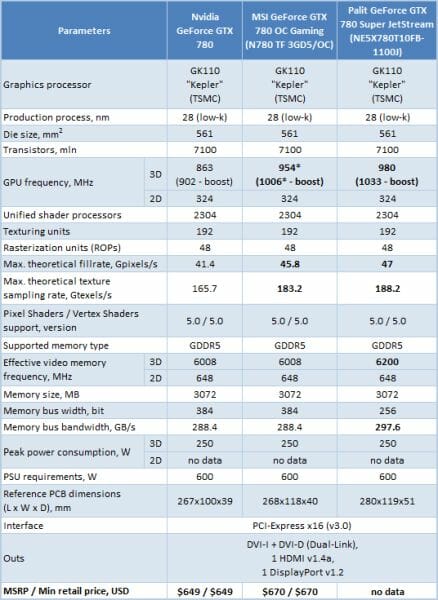
MSI GeForce GTX 780 OC Gaming 3GB (N780 TF 3GD5/OC)
After our review of the MSI GeForce GTX 760 OC Gaming the packaging of the new GeForce GTX 780 OC Gaming looks already familiar. It is a small and eye-catching cardboard box embellished with a picture of a silver dragon.
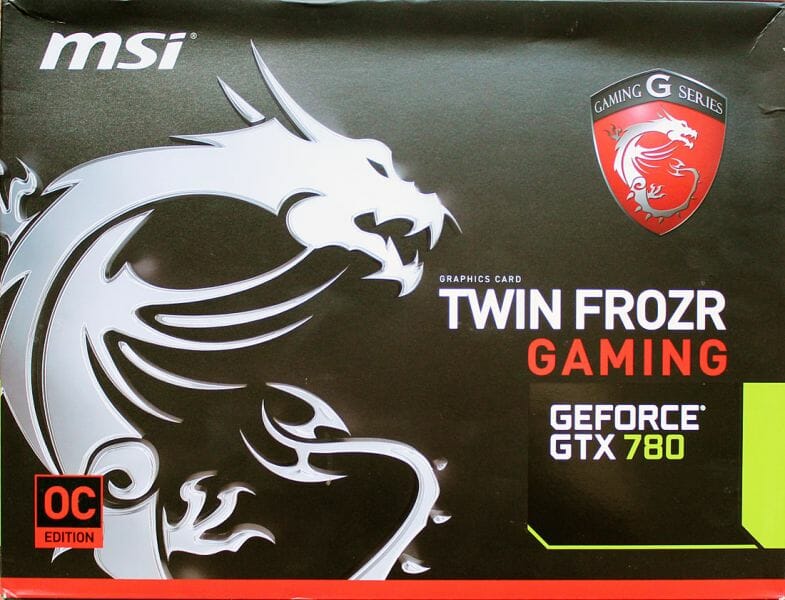
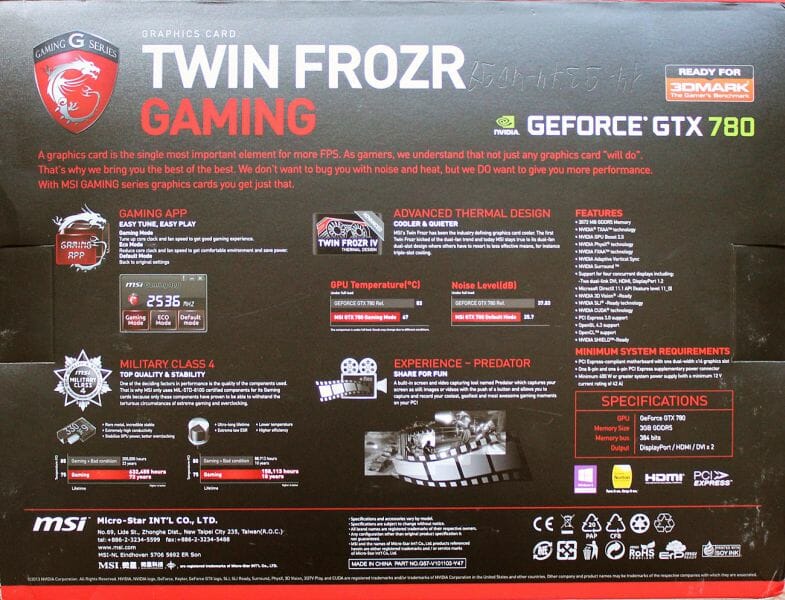
The product specs, system requirements and key features are listed on the back of the box.
Included with the card are two power adapters, a DVI->D-Sub adapter, a CD with drivers and a brief installation guide.
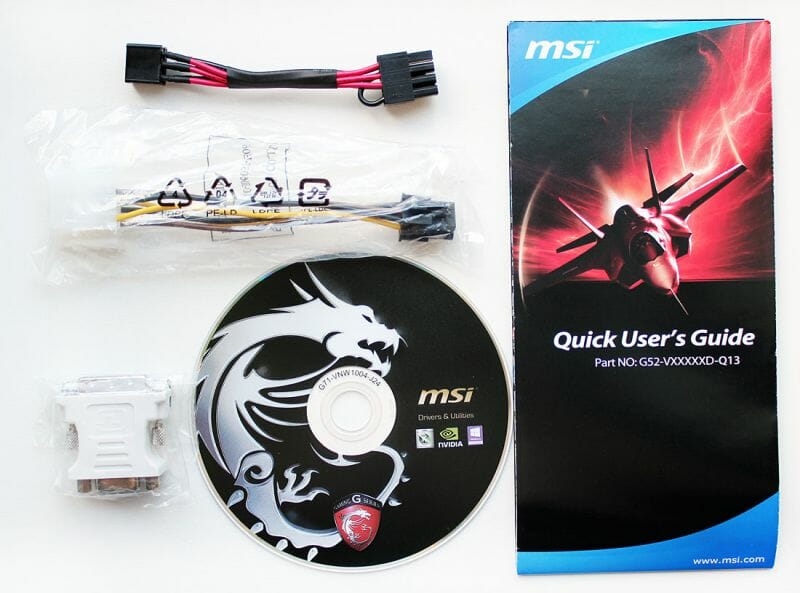
The card is manufactured in China and comes with a 3-year warranty. Its retail price is $670.
The new GeForce GTX 780 OC Gaming is almost no different visually from the MSI GeForce GTX 760 OC Gaming because its face side is covered with the same cooler.
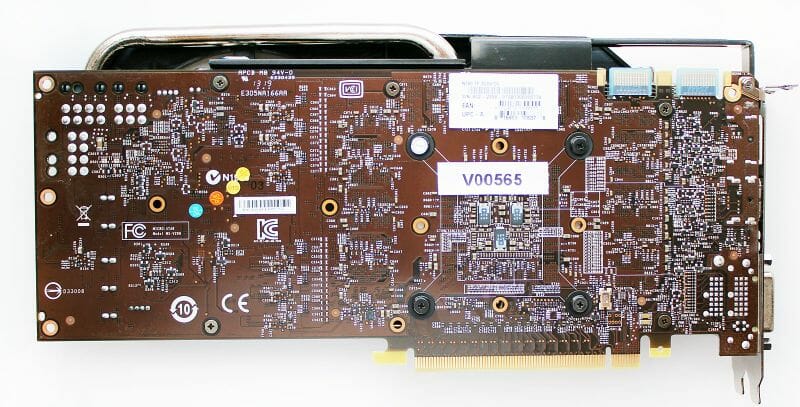
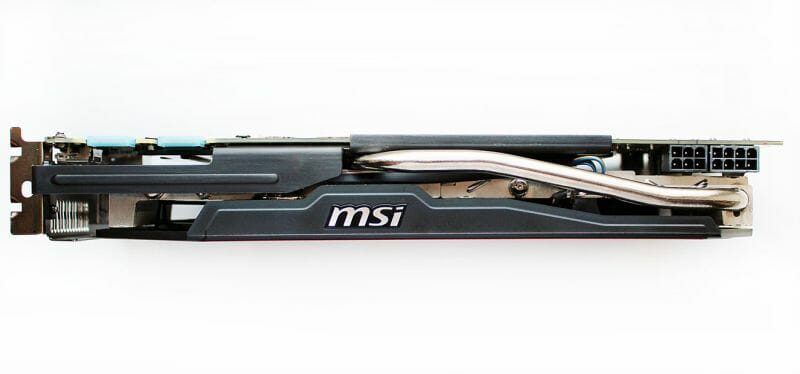
The GeForce GTX 780 is just larger at 268x118x40 mm. All of its connectors have neat plastic caps. The card is equipped with dual-link DVI-I and DVI-D ports, one HDMI version 1.4a, and one DisplayPort version 1.2.
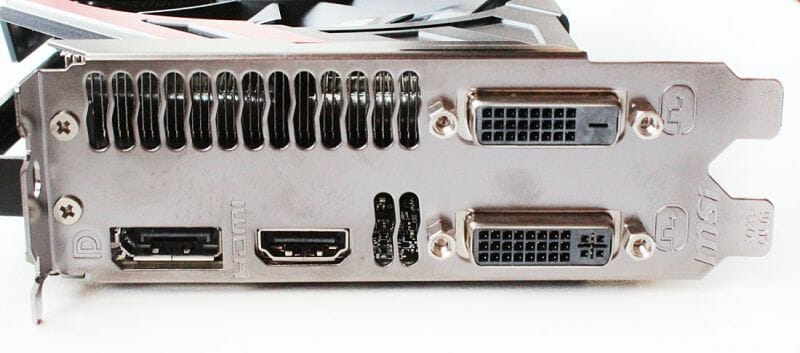
Compared to the MSI GeForce GTX 760 OC Gaming, the vent grid in the mounting bracket is larger. There are no differences about the SLI and power connectors:
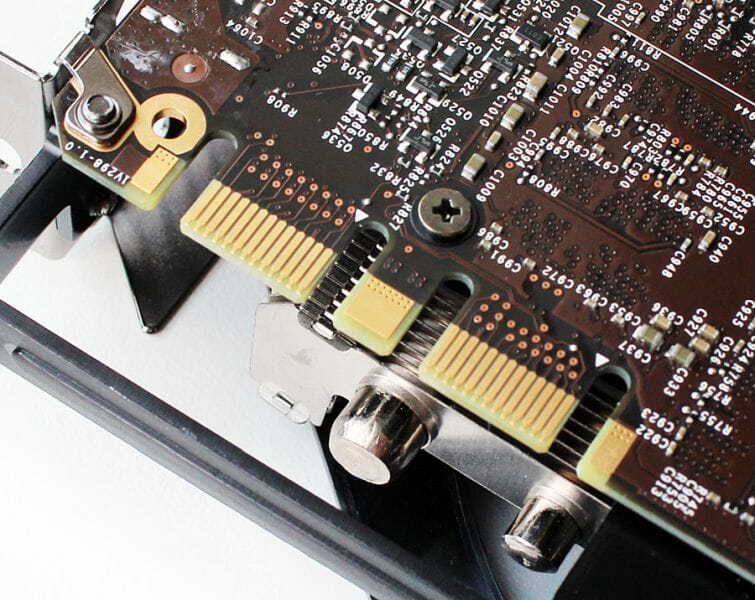
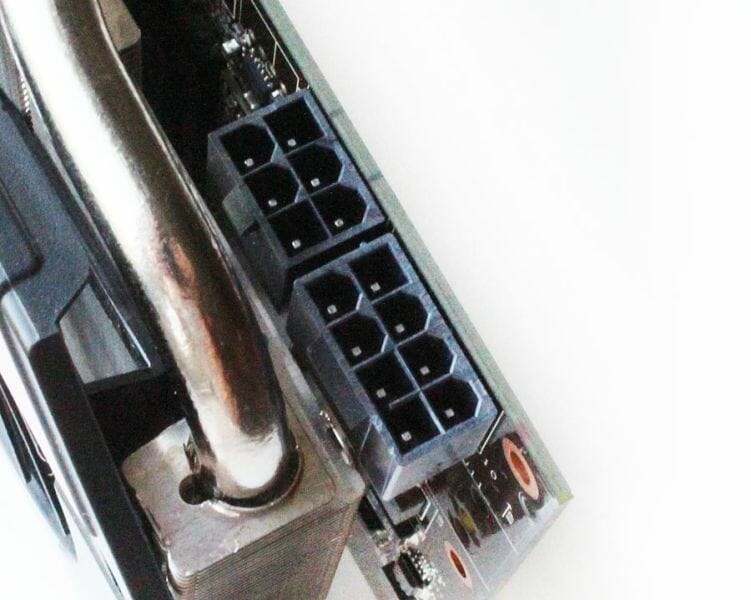
The GeForce GTX 780 can be combined into SLI configurations consisting of up to four such cards and needs about 250 watts of power. A 600-watt or higher PSU is recommended for a computer with one GTX 780 inside. It is as inconvenient to detach the power cables from this card as from the MSI GeForce GTX 760 OC Gaming.
The cooling system is secured with four screws around the GPU. After removing it, we can see the PCB and a metallic plate on the power components:
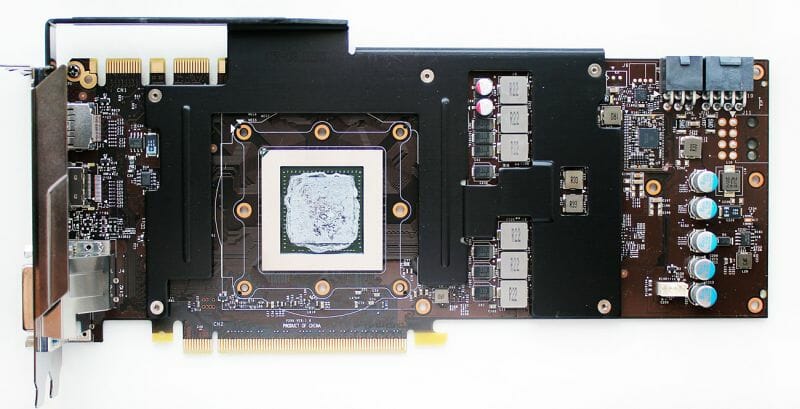
The card uses the reference GeForce GTX 780 PCB design which in its turn is an exact copy of the GeForce GTX Titan.
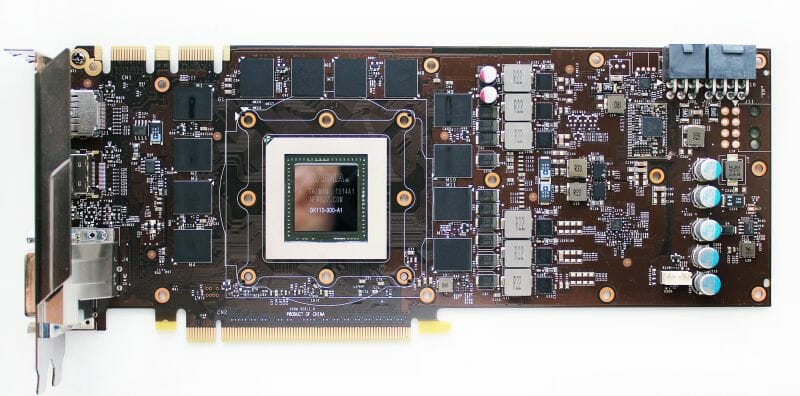
The power system includes six phases for the GPU and three phases for the graphics memory and PLL.
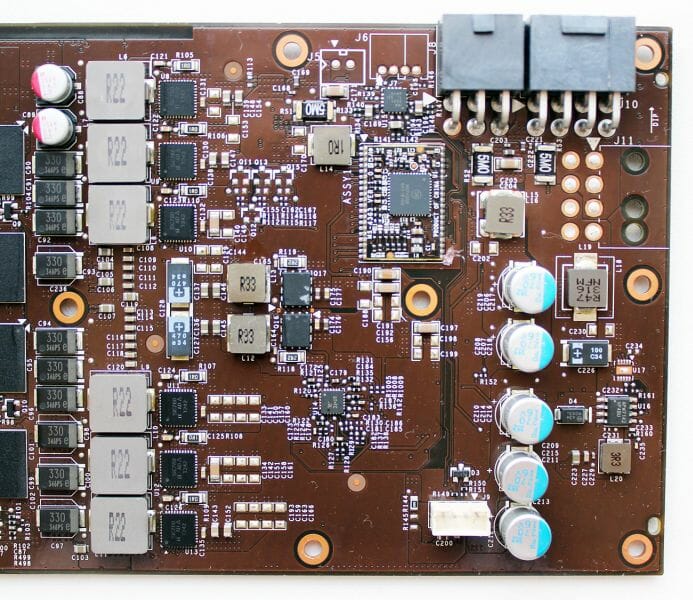
The GPU voltage regulator is managed by an NCP4206 controller from ON Semiconductor.
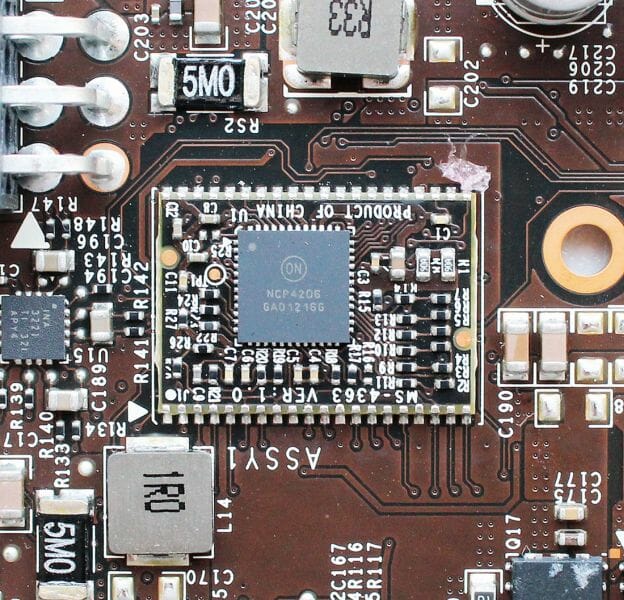
The MSI card features premium Military Class IV components complying with the American military standard MIL-STD-810G. Like on the MSI GeForce GTX 760 OC Gaming, we can see here aluminum-core solid-state capacitors with ultra-low resistance and 10-year service life, economical 93% efficient Hi-c capacitors, and Super Ferrite Chokes with 20% higher energy efficiency and 30% higher current capacity compared to ordinary chokes.
The GK110 chip was manufactured in Taiwan on the 14th week of 2013 (the first week of April). It is revision A1.
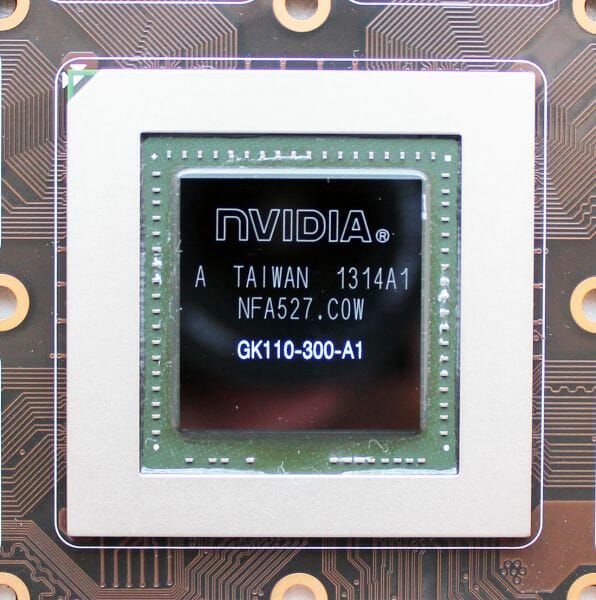
Its base clock rate in 3D mode is 902 MHz (boostable to 954 MHz). Using MSI Gaming App we already told you about in an earlier review, you can raise the clock rates up to 954/1006 MHz with a single click. The reference GeForce GTX 780 from Nvidia works at 863/902 MHz, so MSI’s factory overclocking amounts to a substantial 10.5%.
According to GPU-Z, the ASIC quality of the GPU is 70.5%.
The MSI card has 3 GB of GDDR5 memory in twelve K4G20325FD-FC03 chips from Samsung Semiconductor:
The memory chips are rated for 6000 MHz and that’s exactly the memory frequency of the MSI GeForce GTX 780 OC Gaming. Unfortunately, MSI still omits to overclock memory, so this model has the following specs:
The card is equipped with the exclusive Twin Frozr IV cooler. Although it is named exactly like cooler of the GeForce GTX 760 OC Gaming, the heatsink is somewhat different:
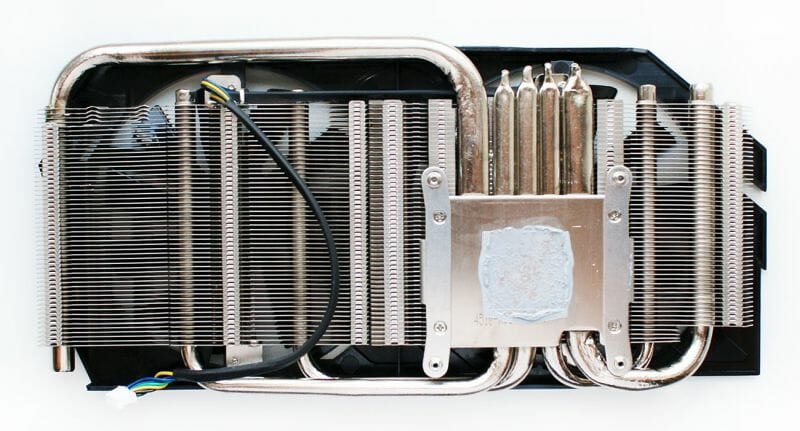
It has an additional 8mm heat pipe although its size hasn’t changed:
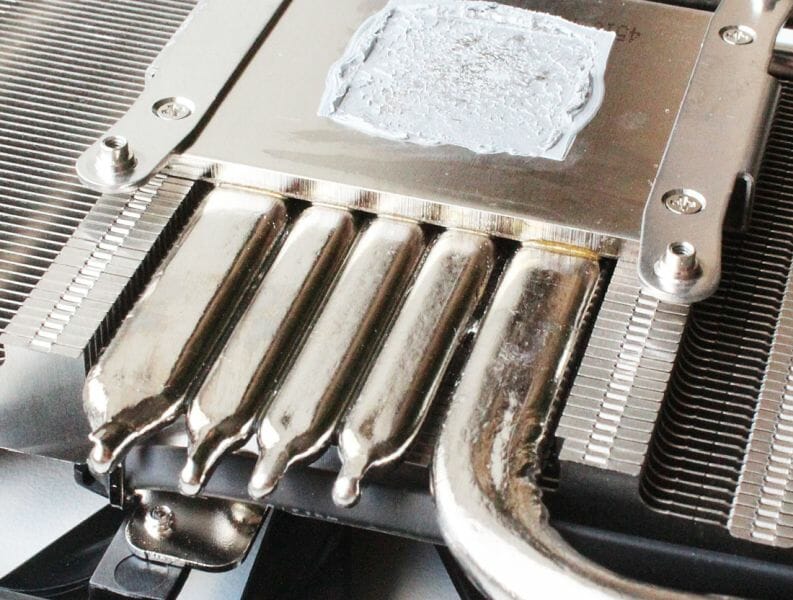
The heat pipes are soldered to the nickel-plated copper base as well as to the heatsink fins. The power components and memory chips are cooled by a steel plate with thermal pads:
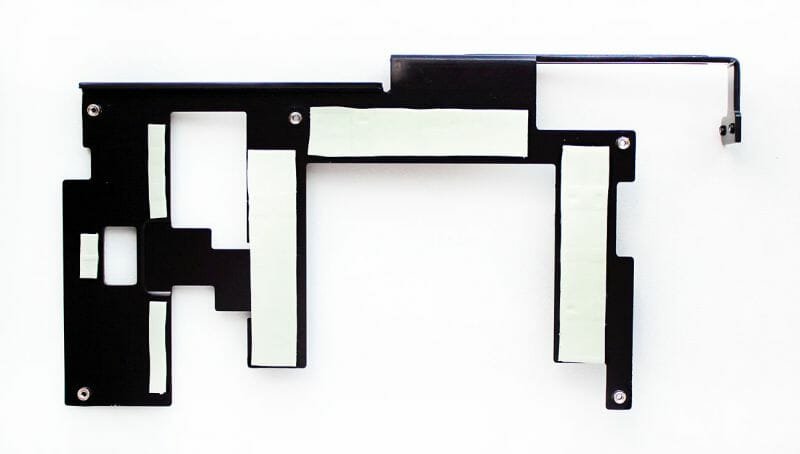
The heatsink carries two 100mm Power Logic PLD10010S12HH fans:
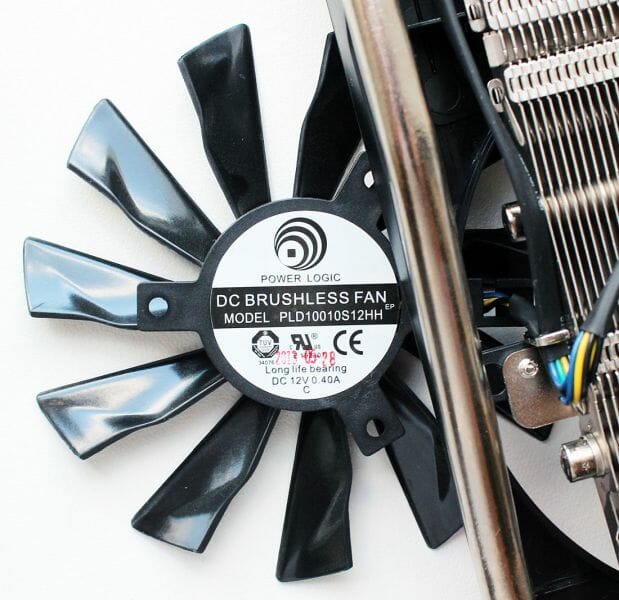
With PWM-based regulation, their speed varies from 900 to 3000 RPM. The fans support Dust Removal technology (temporary backward rotation when shutting down to remove dust).
Hereinafter, to check out the cards temperatures we used five runs of the pretty resource-hungry Aliens vs. Predator (2010) benchmark at the highest visual quality settings, at a resolution of 2560×1440 pixels. We used 16x anisotropic filtering but no MSAA 4x:
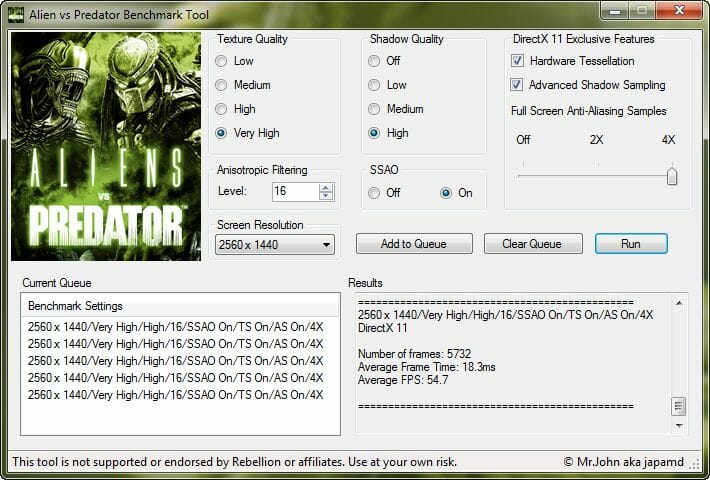
We used MSI Afterburner 3.0.0 beta 11 and GPU-Z version 0.7.2 for monitoring of temperatures inside the closed system case, which configuration is discussed in detail in the corresponding chapter of the roundup. All tests were performed at 26°C room temperature.
We made sure of the high efficiency of the MSI Twin Frozr IV on a GeForce GTX 760 in our earlier review. Now let’s see how this cooling system performs on the hotter GeForce GTX 780.
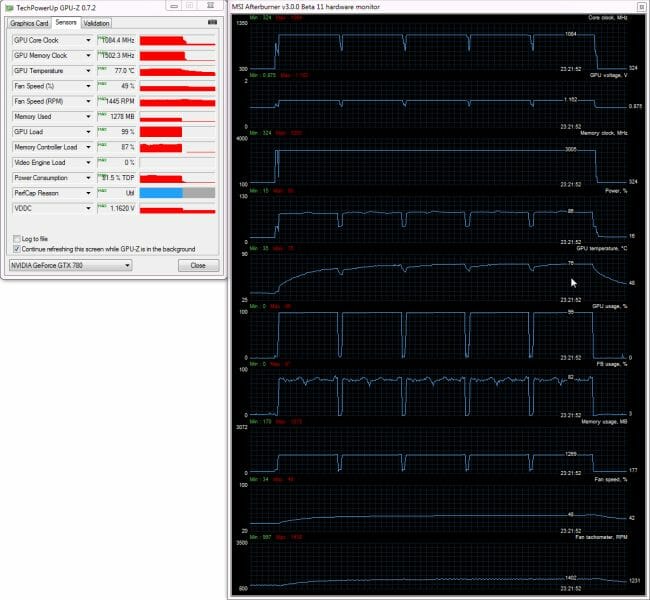
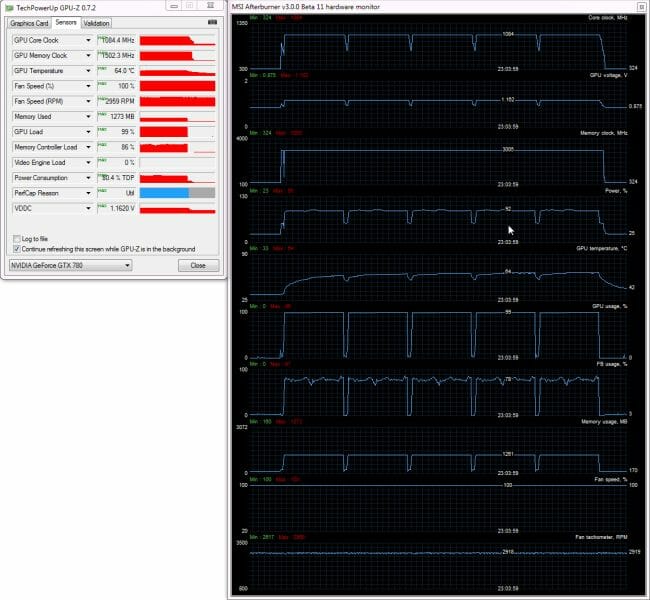
It is efficient indeed, as you can see. With the fans regulated automatically, their speed was no higher than 1450 RPM while the GPU was only 77°C hot. At the maximum speed of 2960 RPM the GPU was 64°C hot. We should remind you that these results were achieved on a GeForce GTX 780 overclocked to GPU frequencies of 954/1006 MHz. Moreover, according to the monitoring graphs, the clock rate of the GK110 chip would peak up to 1084 MHz on the MSI card. So again, the Twin Frozr IV is impressively efficient indeed.
The MSI card impressed us with its overclocking potential as well. Without any voltage or cooling modifications, we managed to increase its GPU frequency by 140 MHz and its memory frequency, by 1240 MHz.
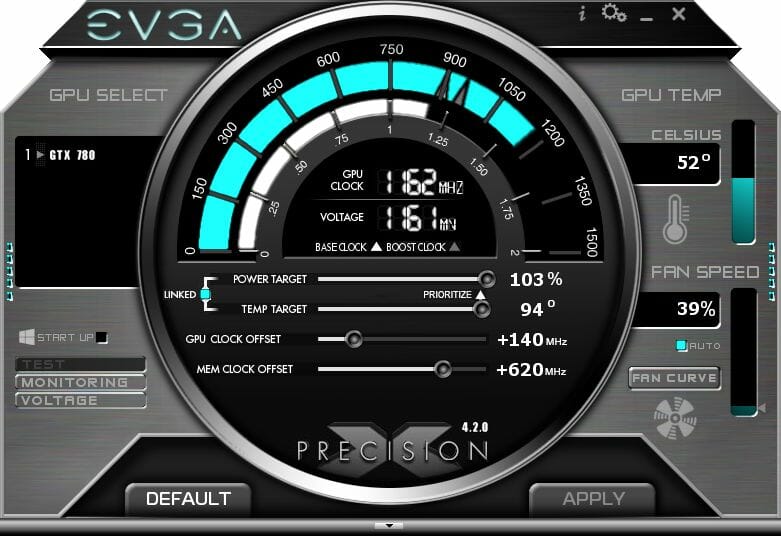
Thus, the resulting clock rates were 1042/1094/7248 MHz.
The overclocked card didn’t present any problem to the Twin Frozr IV which kept the GPU temperature at 78°C in the automatic fan regulation mode (1640 RPM).
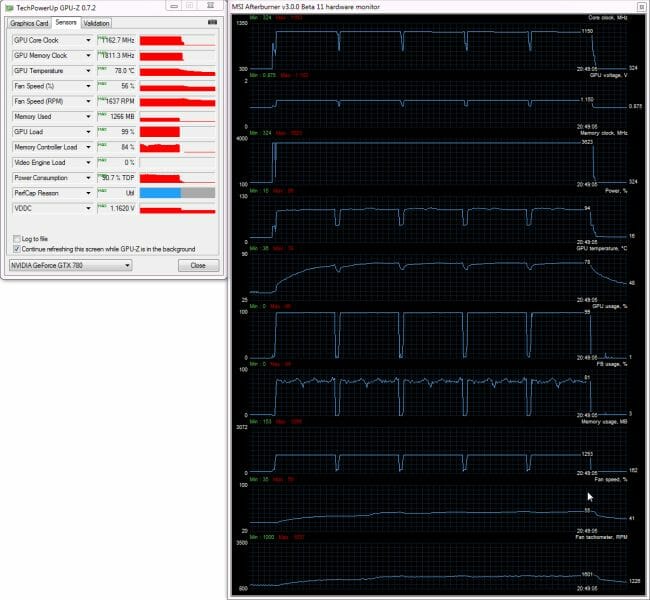
Palit GeForce GTX 780 Super JetStream 3GB (NE5X780T10FB-1100J)
Palit Microsystems offers three GeForce GTX 780s: a copy of the reference card, a JetStream series model, and a Super JetStream model. The latter is going to be covered here.
The huge cardboard box is designed in Palit’s traditional style. The card’s model name, memory amount and technologies are listed on the front of the packaging. On the back, there is a detailed description of Nvidia innovations and system requirements for the GeForce GTX 780.
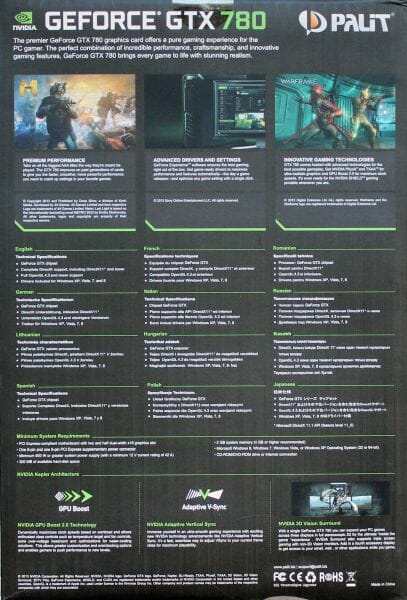
The box has a flip-back cover, so you can take a look at the card through a plastic window and read about its key features.
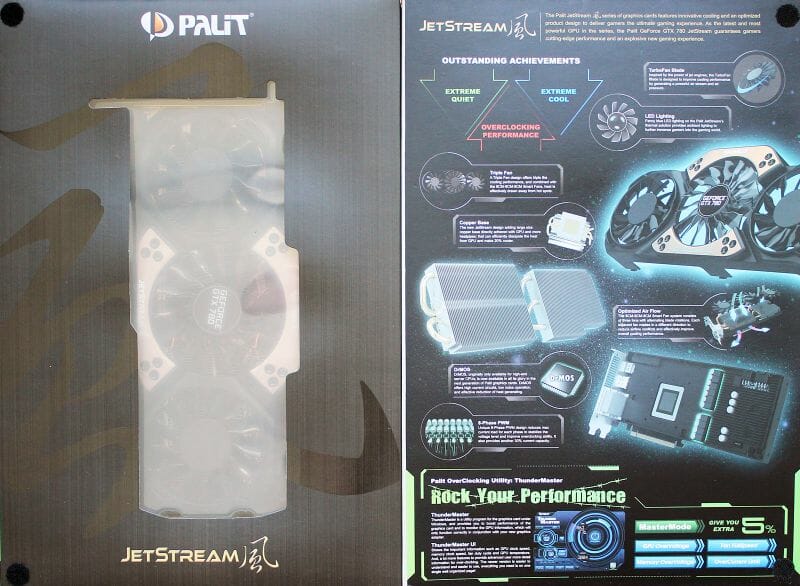
The accessories aren’t numerous for a top-class product: DVI->D-Sub and HDMI->DVI adapters, one power cable, a software CD, a brief installation guide, and a sticker.
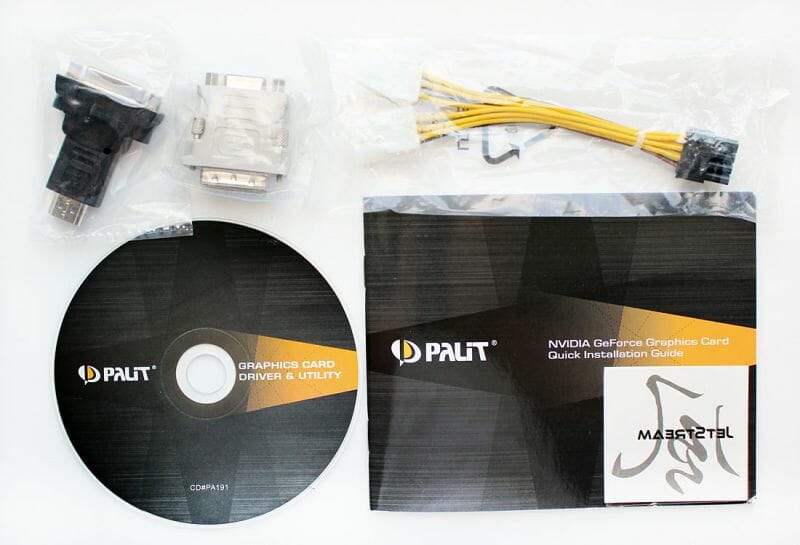
The Palit card is manufactured in China and comes with a 2-year warranty. We couldn’t find out its recommended price.
The Palit GeForce GTX 780 Super JetStream looks heavy. Its face side is covered with a cooling system that has a plastic frame with two gold-colored inserts. The central fan is larger and has a translucent impeller. The other two fans have ordinary black impellers.
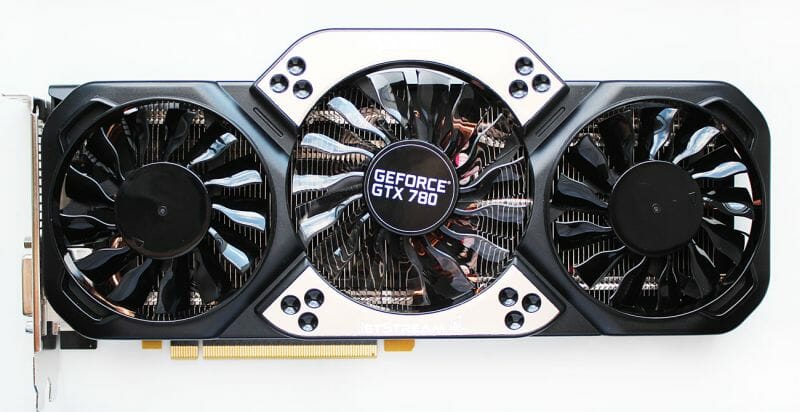
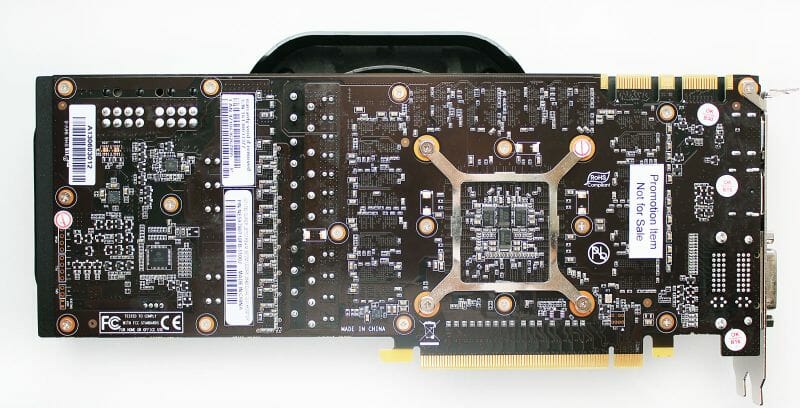
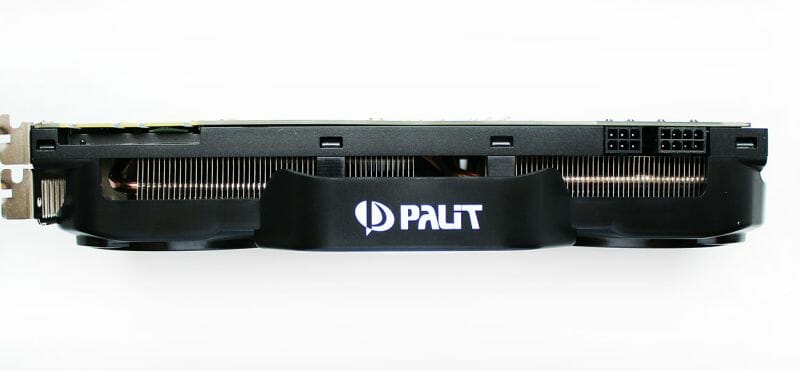
The graphics card is thicker than the reference GeForce GTX 780 at 280x119x51 mm, so in a SLI configuration it has to be installed into the bottom PCIe slot (or the mainboard must have two PCIe slots far apart from each other).
The Palit version is no different from the reference sample in terms of video, MIO and power connectors:
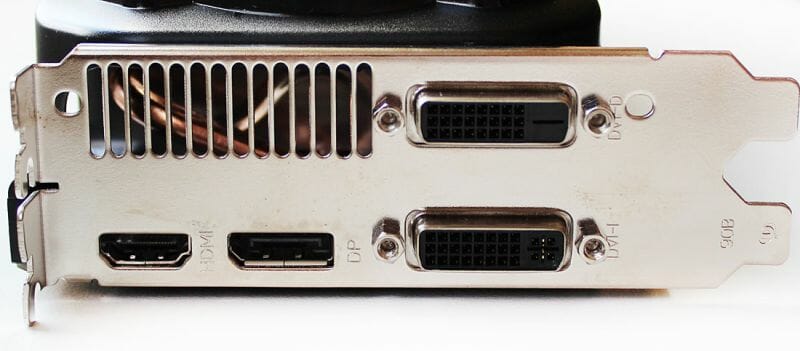
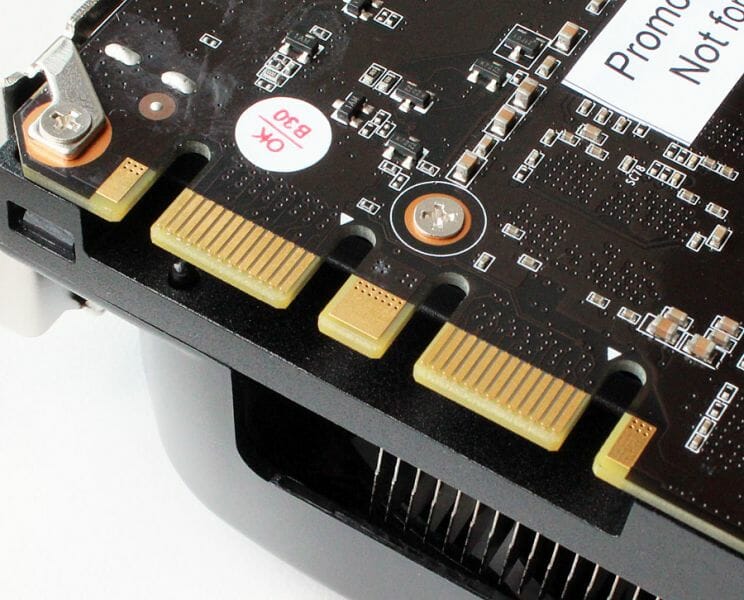
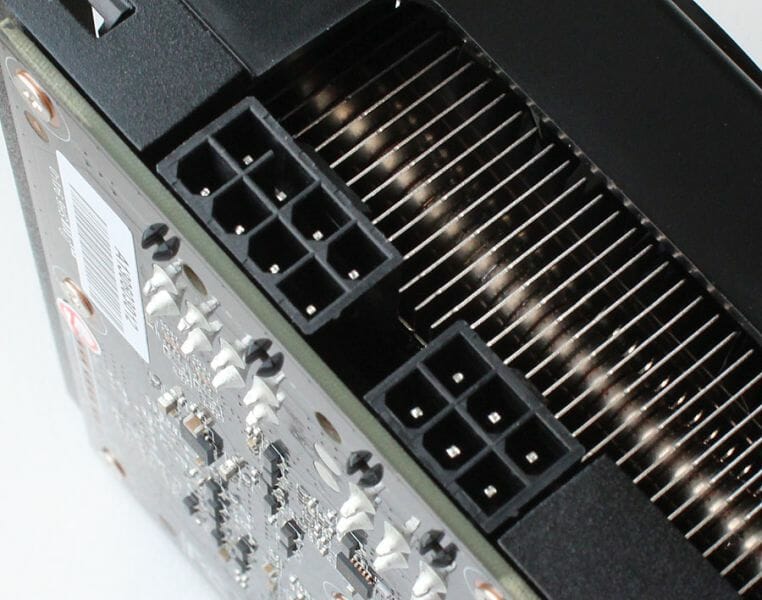
The GeForce GTX 780 Super JetStream features an original PCB:
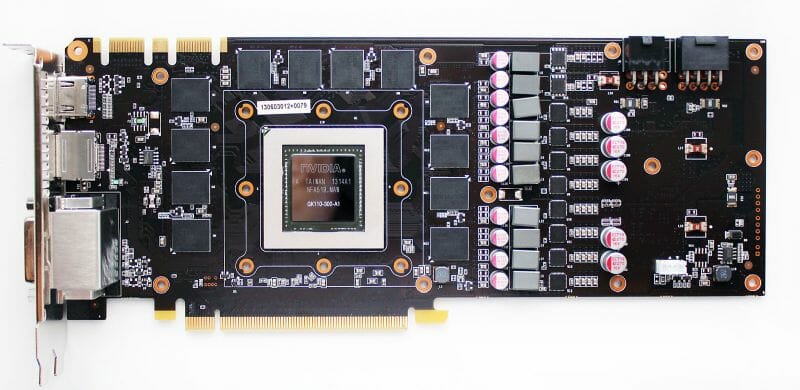
The 8-phase GPU voltage regulator is based on DrMOS transistors:
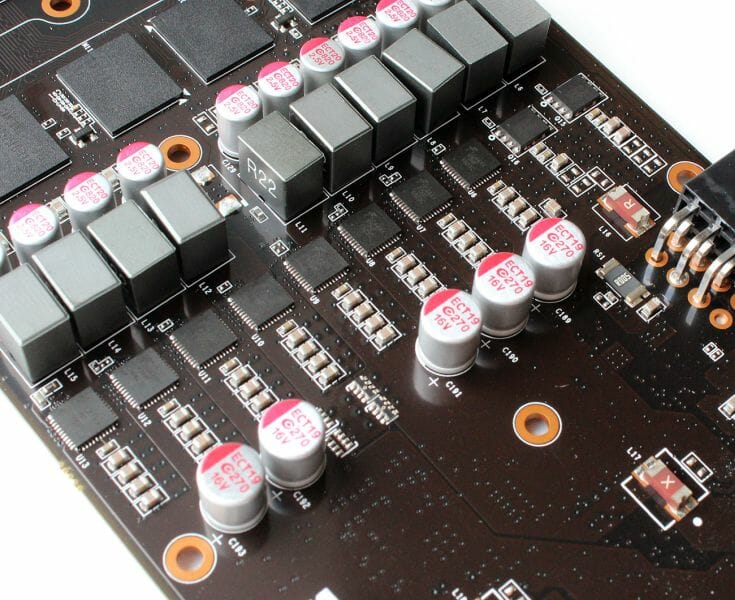
It is managed by an NCP4208 controller:
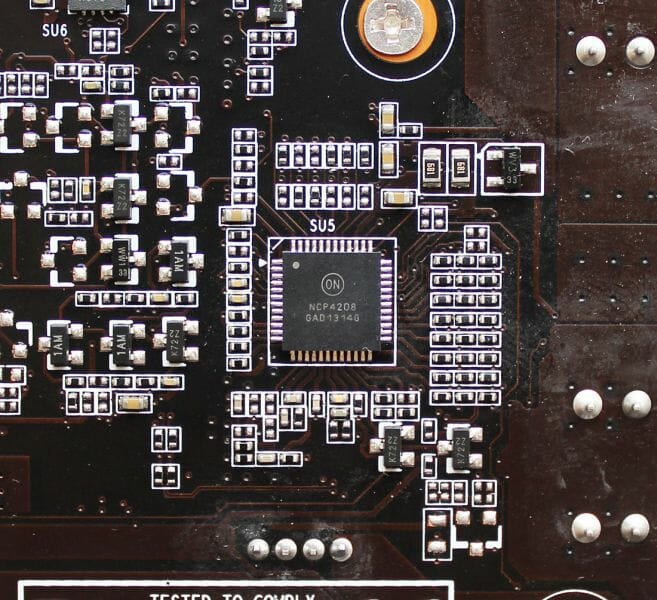
There are also two power phases for the memory chips.
The PCB has three check points for measuring GPU, memory and PLL voltages.
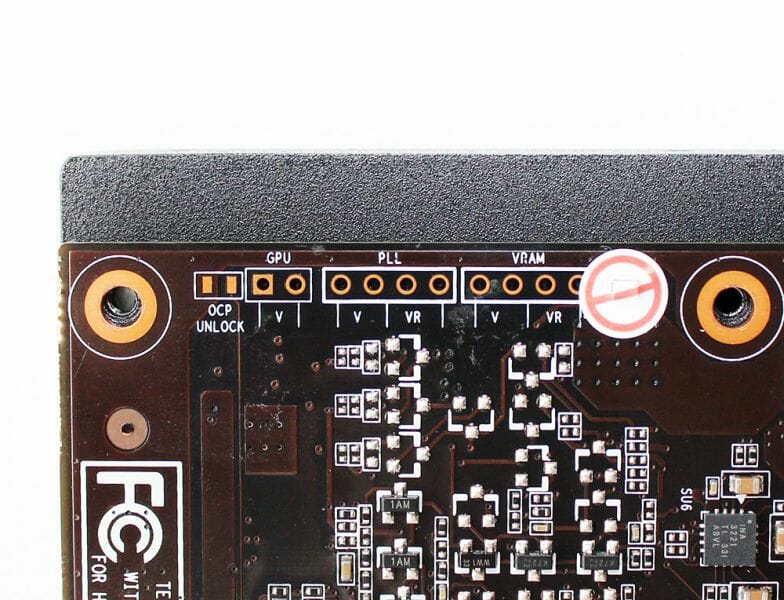
The OCP Unlock feature you can see nearby seems to be used to remove any limitations on voltages, power targets and frequencies. So, it looks like we have a good toolset for extreme overclocking here, although Palit has never positioned itself as a brand for hardcore overclockers.
The GPU of the Palit card was manufactured on the same week as the MSI’s. It is revision A1, too.
Its frequencies in 3D mode are pre-overclocked by 13.6% to 980/1033 MHz. The ASIC quality of the chip is 66%.
The card’s graphics memory is pre-overclocked as well. Instead of 6008 MHz, it works at 6200 MHz. These are the same Samsung chips as we’ve seen on the MSI:
Here are the specifications of the super card from Palit:
The cooling system consists of three separate components: a plastic frame with three fans, a dual-section GPU heatsink, and a steel heat-spreader on the memory chips and power components.
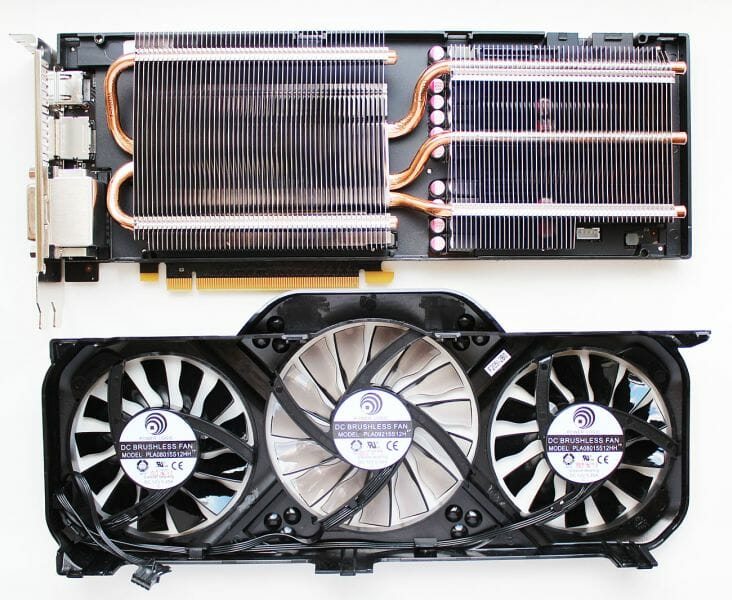
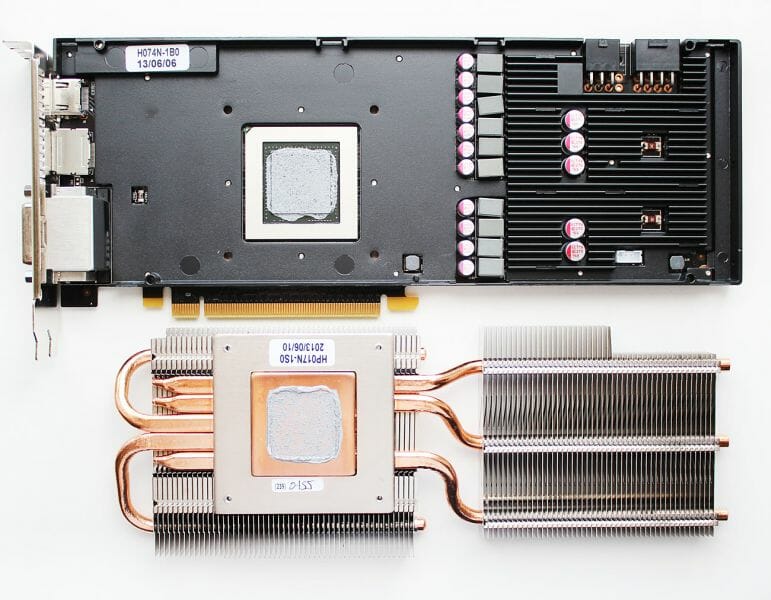
The steel heat-spreader envelops the PCB like a kind of thermal armor that has additional fins on the transistors.
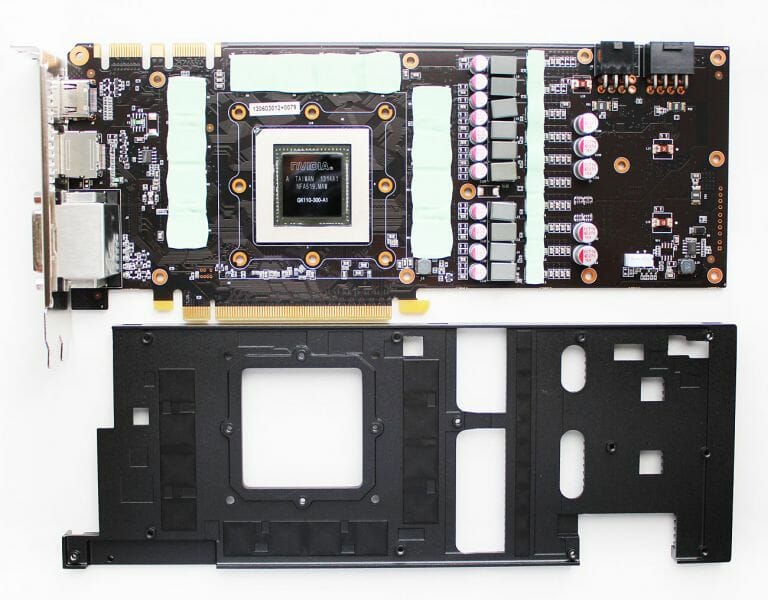
The GPU heatsink consists of two sections and has five copper heat pipes, 6 mm in diameter. Two of them pierce the main section that has a copper base. The other three service the auxiliary section of the heatsink.
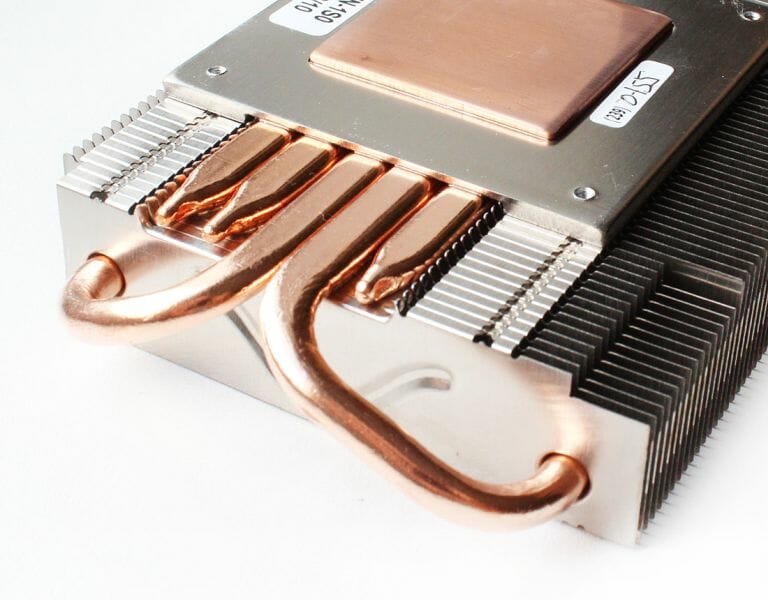
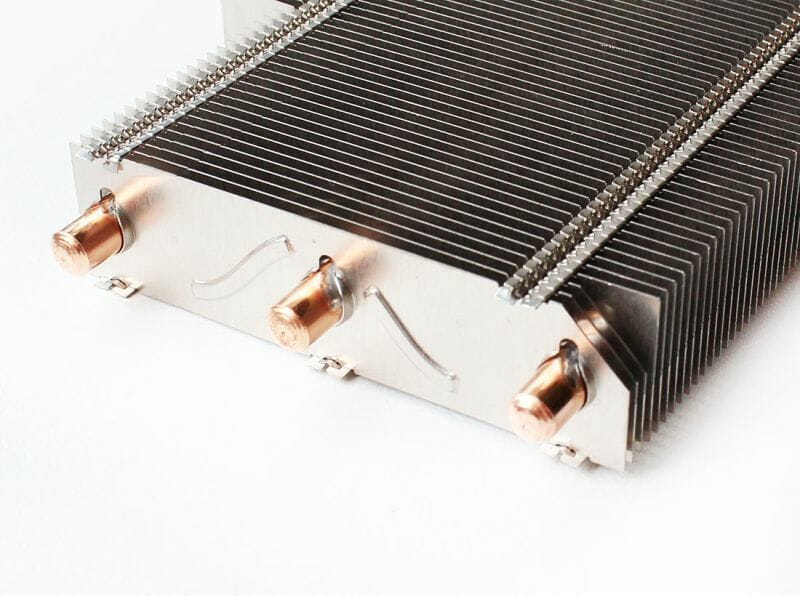
There’s a lot of aluminum fins soldered to the heat pipes. The cooler is neatly assembled and rather heavy.
There are three fans cooling the heatsink. The central fan has a diameter of 92 mm and a highlighted translucent impeller. The two other fans are only 80mm in diameter.
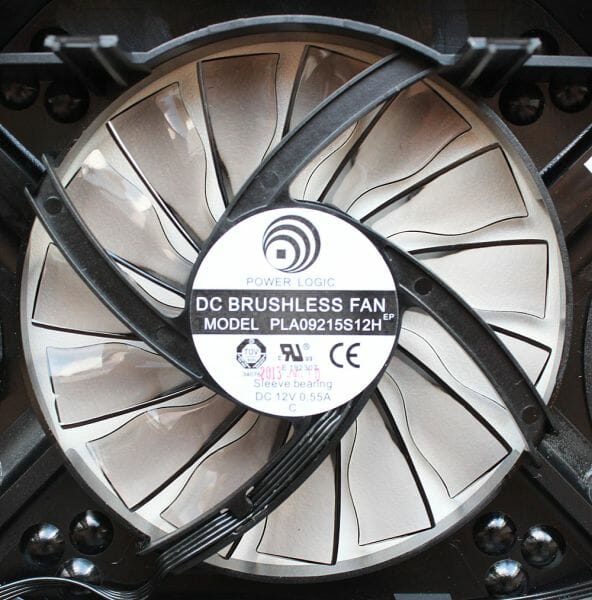
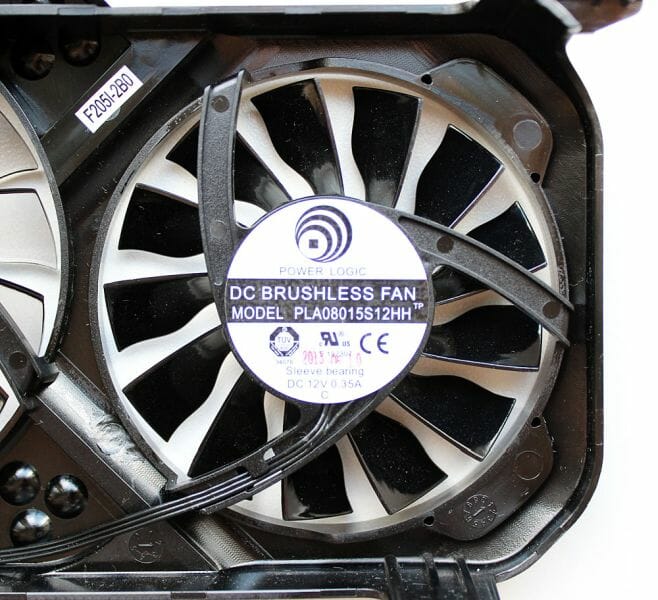
All of them are manufactured by Power Logic, run on fluid dynamic bearings and support PWM-based regulation. Their speed varies from 800 to 2800 RPM.
Palit’s cooler is no less efficient than MSI’s. With the fans regulated automatically (1580 RPM), the GPU is 77°C hot. It’s the same temperature as with the MSI, but the Palit’s GPU works at a higher clock rate.
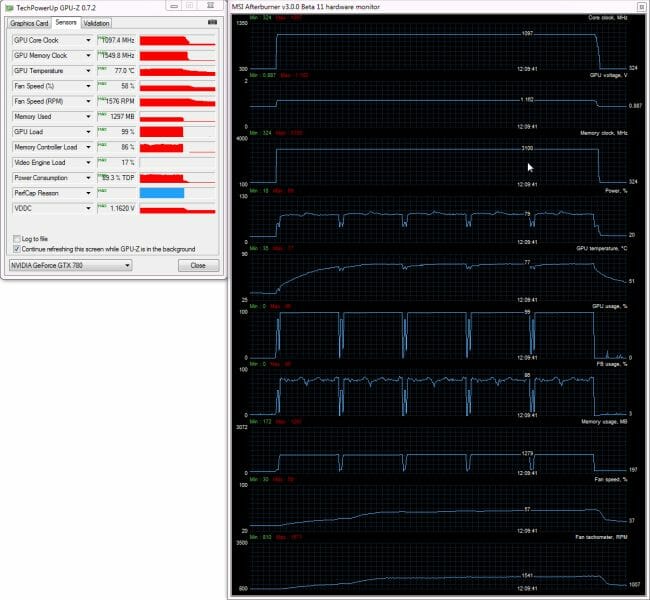
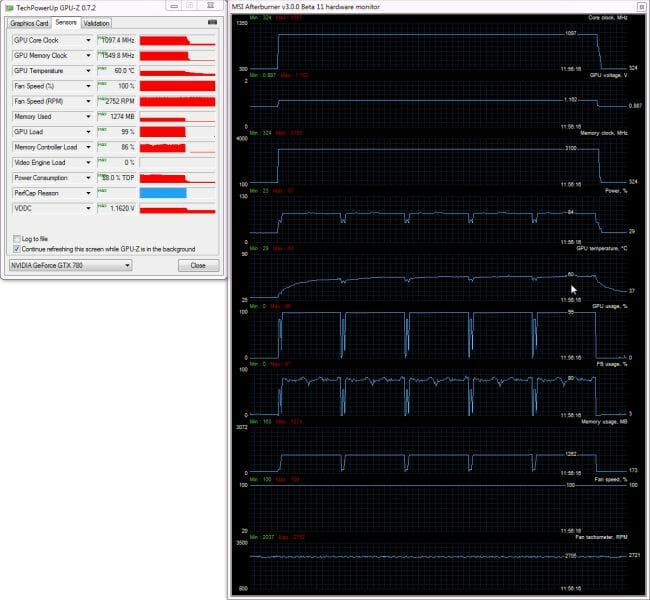
At the maximum speed of 2750 RPM the GPU is somewhat colder at 60° than on the MSI card. That’s just an excellent result.
Unfortunately, the Palit was not as good in our overclocking experiments as the MSI. We only managed to increase its GPU and memory clock rates by 65 and 1200 MHz without compromising on stability or image quality.
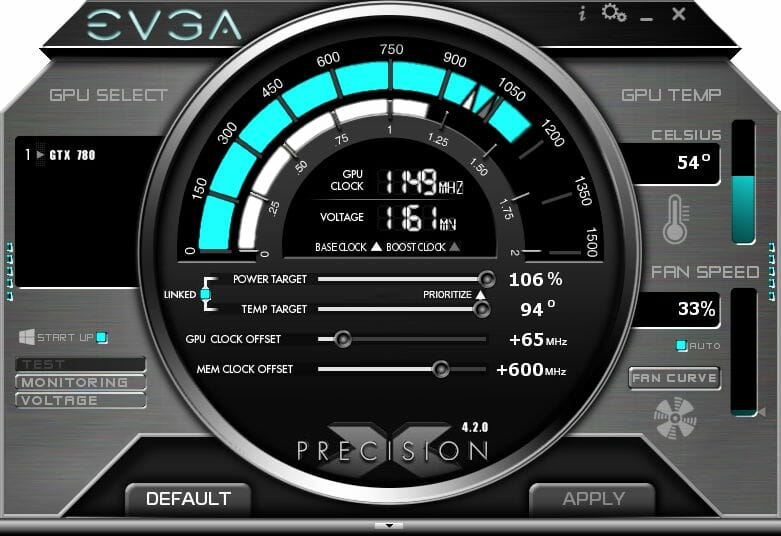
The resulting clock rates were 1045/1098/7400 MHz.
The GPU clock rate would peak up to 1150 MHz, which is a mere 13 MHz lower than the peak GPU frequency of the overclocked MSI. It must be noted that the temperature and fan speed of the Palit card didn’t change when it was overclocked.
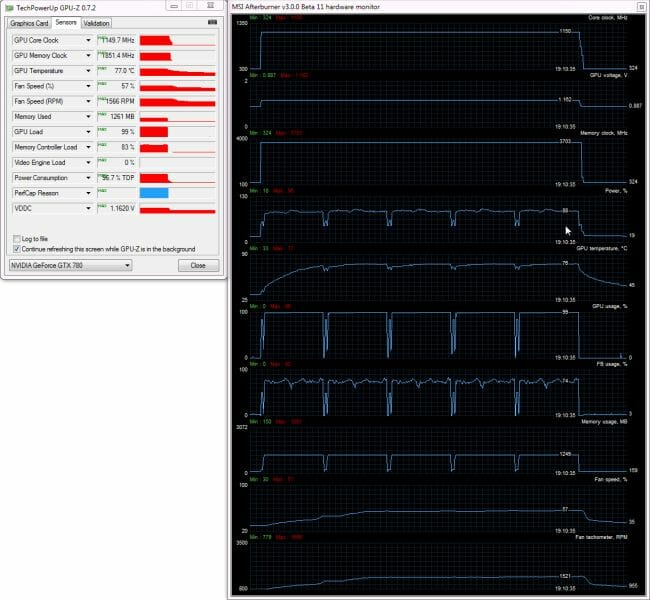
It is the same 77°C at 1570 RPM.
Noise Level and Power Consumption
The noise level of each cooler was measured between 1:00 and 3:00 AM in a closed room about 20 m2 big using CENTER-321 electronic noise meter. The noise level for each cooler was tested outside the system case when the only noise sources in the lab were the cooler and its fan. The noise meter was installed on a tripod and was always at a 150 mm distance from the cooler fan rotor. The tested cooling systems were placed at the edge of the desk on a sheet of polyurethane foam. The lowest noise reading our noise meter device can register is 29.8 dBA and the subjectively comfortable noise level in these testing conditions was around 36 dBA (do not mix it up with low noise level). The fan(s) rotation speed was adjusted in the entire supported range using our precise in-house controller by changing the voltage with 0.5 V increment.
The vertical dotted lines mark the peak speed of the coolers’ fans in the automatic speed regulation mode. Here’s the diagram:
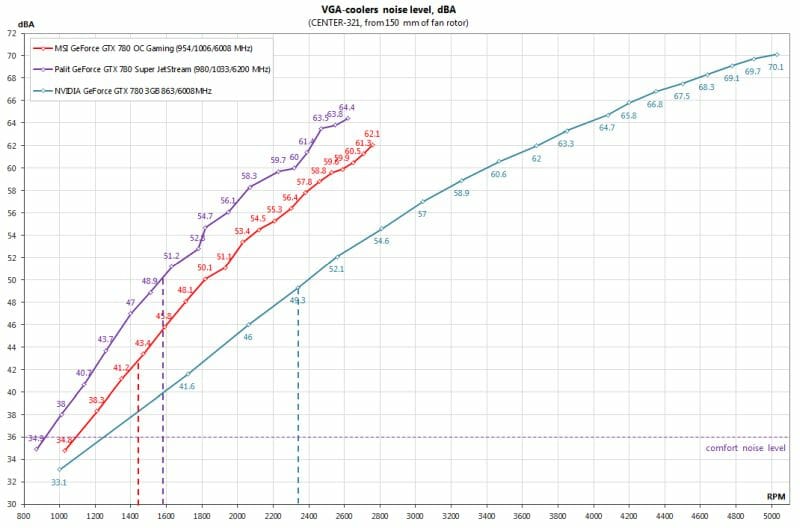
Although the noise level graphs of the MSI and Palit go higher than the reference GeForce GTX 780’s, only one of them is noisier in 3D applications. It is the Palit GeForce GTX 780 JetStream as you can easily see by the dotted line that shows the peak speed of the fans in the automatic regulation mode. But, frankly speaking, Palit’s cooler is not very different from Nvidia’s. The MSI GeForce GTX 780 OC Gaming, on its part, is quieter than both its opponents and is more comfortable subjectively, yet it can only be called silent in 2D applications. That said, we are still very fond of the MSI Twin Frozr IV cooler which is currently one of the best solutions available in terms of performance/noise ratio.
We measured the power consumption of our testbed equipped with different graphics cards using a multifunctional Zalman ZM-MFC3 panel which can report how much power a computer (without the monitor) draws from a wall outlet. There were two test modes: 2D (editing documents in Microsoft Word or web surfing) and 3D. In the latter case the load was created by four runs of the introductory “Swamp” scene in Crysis 3 game at 2560×1440 with maximum image quality settings, but without MSAA.
In our today’s power consumption tests we compare the original GeForce GTX 780s with two SLI-linked GTX 780s (at the same frequencies of 980/6208 MHz), AMD Radeon HD 7990 and Nvidia GeForce GTX 690 (we’ll use these dual-processor cards in our performance benchmarks as well).
It is the 2-way SLI configuration with two overclocked GeForce GTX 780s that needs the most power. It requires 114 watts more at peak load than the Nvidia GeForce GTX 690 configuration and 22 watts more than the dual-processor AMD Radeon HD 7990. The difference from the single GeForce GTX 780 is 223 watts, which is close to the specified power consumption of one GTX 780 (250 watts). We can also note that the difference between the configurations with the two GeForce GTX 780 cards from MSI and Palit is only 11 watts. It is due to the difference in the cards’ clock rates.
Testbed Configuration and Testing Methodology
All participating graphics cards were tested in a system with the following configuration:
- Mainboard: Intel Siler DX79SI (Intel X79 Express, LGA 2011, BIOS 0559 from 03/05/2013);
- CPU: Intel Core i7-3970X Extreme Edition, 3.5/4.0 GHz (Sandy Bridge-E, C2, 1.1 V, 2 x 256 KB L2, 15 MB L3);
- CPU cooler: Phanteks PH-TC14PE (2 x Corsair AF140 fans at 900 RPM);
- Thermal interface: ARCTIC MX-4;
- Graphics cards:
- AMD Radeon HD 7990 2×3 GB 1100/6200 MHz;
- Nvidia GeForce GTX 690 2 x 2 GB 1032/1137/6208 MHz;
- MSI GeForce GTX 780 OC Gaming 3 GB (N780 TF 3GD5/OC) 954/1006/6008 MHz and 980/1033/6208 MHz in 2-way SLI configuration;
- Palit GeForce GTX 780 Super JetStream 3 GB (NE5X780H10FB-1100J) 980/1033/6208 MHz).
- System memory: DDR3 4 x 8 GB G.Skill TridentX F3-2133C9Q-32GTX: 2133 MHz / 9-11-11-31 / 1.6 V;
- System drive: Crucial m4 256 GB SSD (SATA-III,CT256M4SSD2, BIOS v0009);
- Drive for programs and games: Western Digital VelociRaptor (300GB, SATA-II, 10000 RPM, 16MB cache, NCQ) inside Scythe Quiet Drive 3.5” HDD silencer and cooler;
- Backup drive: Samsung Ecogreen F4 HD204UI (SATA-II, 2 TB, 5400 RPM, 32 MB, NCQ);
- System case: Antec Twelve Hundred (front panel: three Noiseblocker NB-Multiframe S-Series MF12-S2 fans at 1020 RPM; back panel: two Noiseblocker NB-BlackSilentPRO PL-1 fans at 1020 RPM; top panel: standard 200 mm fan at 400 RPM);
- Control and monitoring panel: Zalman ZM-MFC3;
- Power supply: Corsair AX1200i 1200 W (with a default 120 mm fan);
- Monitor: 27” Samsung S27A850D (DVI-I, 2560×1440, 60 Hz).
For our 2-way SLI tests we used MSI card as a primary, and Palit card as a secondary:
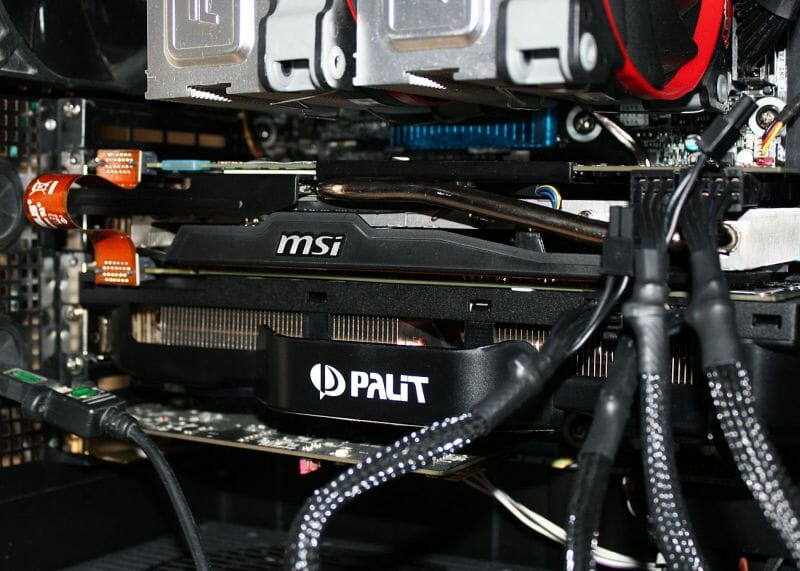
Their clock frequencies were adjusted to be 980/1033/6208 MHz:
Since both our GeForce GTX 780 are different today, we added 100 MHz to the frequencies of each dual-GPU graphics card and 200 MHz of effective memory frequency:
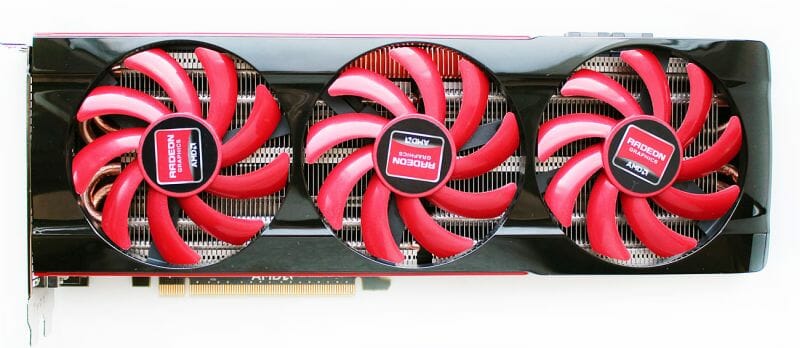
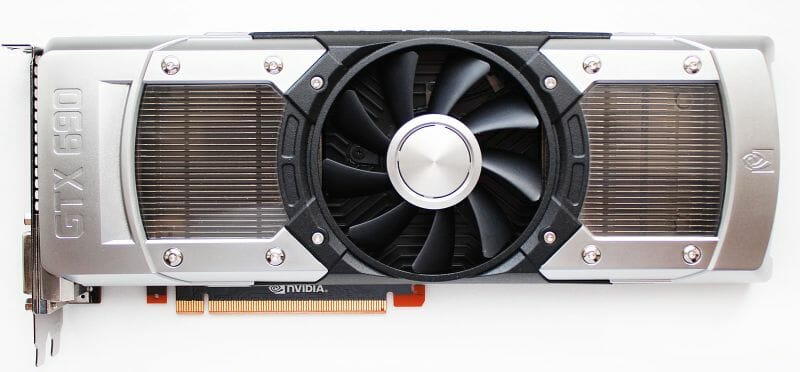
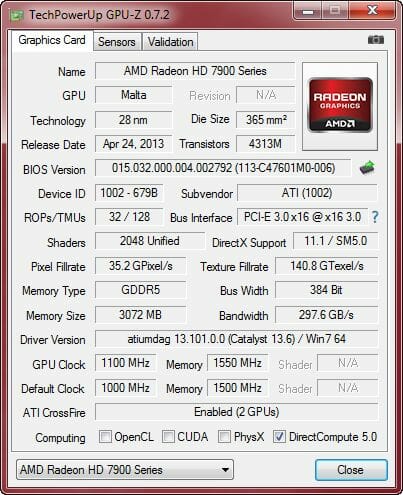
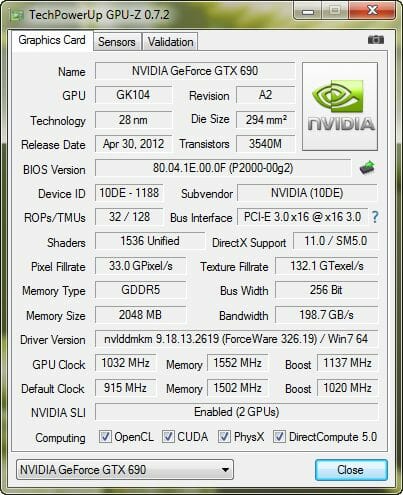
In order to lower the dependence of the graphics cards performance on the overall platform speed, I overclocked our 32 nm six-core CPU with the multiplier set at 48x, BCLK frequency set at 100 MHz and “Load-Line Calibration” enabled to 4.8 GHz. The processor Vcore was increased to 1.38 V in the mainboard BIOS:
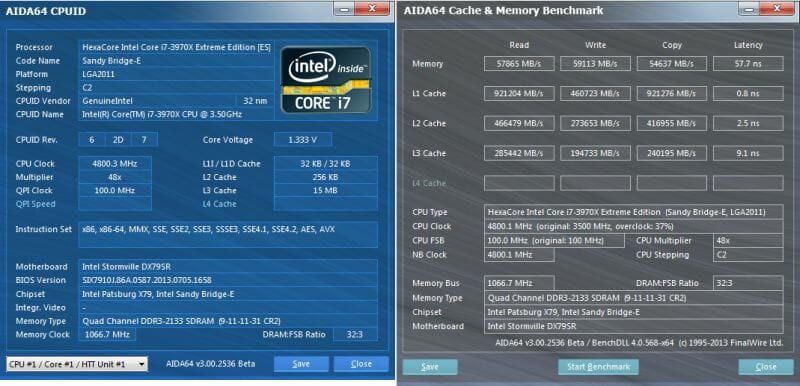
Hyper-Threading technology was enabled. 32 GB of system DDR3 memory worked at 2.133 GHz frequency with 9-11-11-31 timings and 1.6V voltage.
The test session started on July 19, 2013. All tests were performed in Microsoft Windows 7 Ultimate x64 SP1 with all critical updates as of that date and the following drivers:
- Intel Chipset Drivers 9.4.0.1017 WHQL from 03/27/2013 for the mainboard chipset;
- DirectX End-User Runtimes libraries from November 30, 2010;
- Nvidia GeForce 326.19 beta driver for Nvidia based graphics cards;
- AMD Catalyst 13.6 beta 2 driver from 06/04/2013 + Catalyst Application Profiles 13.5 (CAP1) for AMD based graphics cards.
We tested the graphics cards performance in two resolutions: 1920×1080 and 2560×1440. The tests were performed in two image quality modes: “Quality+AF16x” – default texturing quality in the drivers with enabled 16x anisotropic filtering and “Quality+ AF16x+MSAA 4x(8x)” with enabled 16x anisotropic filtering and full screen 4x or 8x antialiasing, in those cases when the average fps rate remained high enough for comfortable gaming experience. We enabled anisotropic filtering and full-screen anti-aliasing from the game settings. If the corresponding options were missing, we changed these settings in the Control Panels of Catalyst and GeForce drivers. We also disabled Vsync there. There were no other changes in the driver settings.
This time we are going to drop the old Metro 2033: The Last Refuge game from the list of benchmarks, since the new Metro: Last Light has already stepped in to completely replace it and has been updated to version 1.0.5. A few other games have also been updated. Now our benchmarking suite includes two popular semi-synthetic benchmarks and 11 resource-consuming games of various genres:
- 3DMark 2013 (DirectX 9/11) – version 1.0, benchmarks in “Cloud Gate”, “Fire Strike” and “Fire Strike Extreme” scenes;
- Unigine Valley Bench (DirectX 11) – version 1.0, maximum image quality settings, AF16x and(or) MSAA 4x, 1980×1080 resolution;
- Total War: Shogun 2: Fall of the Samurai (DirectX 11) – version 1.1.0, built-in benchmark (Sekigahara battle) at maximum graphics quality settings and enabled MSAA 8x in one of the test modes;
- Battlefield 3 (DirectX 11) – version 1.4, all image quality settings set to “Ultra”, two successive runs of a scripted scene from the beginning of the “Going Hunting” mission 110 seconds long;
- Sniper Elite V2 Benchmark (DirectX 11) – version 1.05, we used Adrenaline Sniper Elite V2 Benchmark Tool v1.0.0.2 BETA with maximum graphics quality settings (“Ultra” profile), Advanced Shadows: HIGH, Ambient Occlusion: ON, Stereo 3D: OFF, two sequential test runs;
- Sleeping Dogs (DirectX 11) – version 1.5, we used Adrenaline Sleeping Dogs Benchmark Tool v1.0.2.1 with maximum image quality settings, Hi-Res Textures pack installed, FPS Limiter and V-Sync disabled, two consecutive runs of the built-in benchmark with quality antialiasing at Normal and Extreme levels;
- Hitman: Absolution (DirectX 11) – version 1.0.446.0, built-in test with Ultra image quality settings, with enabled tessellation, FXAA and global lighting;
- Crysis 3 (DirectX 11) – version 1.2.0.1000, all graphics quality settings at maximum, Motion Blur amount – Medium, lens flares – on, FXAA and MSAA4x modes enabled, two consecutive runs of a scripted scene from the beginning of the “Swamp” mission 110 seconds long;
- Tomb Raider (2013) (DirectX 11) – version 1.1.743.0, we used Adrenaline Benchmark Tool, all image quality settings set to “Ultra”, V-Sync disabled, FXAA and 2x SSAA antialiasing enabled, TessFX technology activated, two consecutive runs of the benchmark built into the game;
- BioShock Infinite (DirectX 11) – version 1.1.21.65455, we used Adrenaline Action Benchmark Tool v1.0.2.1, two consecutive runs of the built-in benchmark with “Ultra” and “Ultra+DOF” quality settings;
- Metro: Last Light (DirectX 11) – version 1.0.5, we used built-in benchmark for two consecutive runs of the D6 scene. All image quality and tessellation settings were at “Very High”, “Advanced PhysX technology was enabled, we tested with and without SSAA antialiasing;
- GRID 2 (DirectX 11) – version 1.0.82.8704, we used built-in benchmark, graphics image quality settings were at their maximum in all aspects, the tests were run with and without MSAA 8x antialiasing with eight cars on the Chicago track;
- Company of Heroes 2 beta (DirectX 11) – version 3.0.0.9804, two consecutive runs of the integrated benchmark at maximum image quality and physics effects settings.
If the game allowed recording the minimal fps readings, they were also added to the charts. We ran each game test or benchmark twice and took the best result for the diagrams, but only if the difference between them didn’t exceed 1%. If it did exceed 1%, we ran the tests at least one more time to achieve repeatability of results.
Performance
3DMark 2013
The Cloud Gate scene is too CPU-dependent to reveal the potential of these top-class graphics subsystems, therefore we should consider the Fire Strike results, especially at the extreme graphics quality settings. The GeForce GTX 780 SLI tandem shows good scalability, being 70.7% faster than the single GTX 780 and enjoying a large advantage over both dual-processor products from AMD and Nvidia. The difference between the MSI and Palit is insignificant.
Unigine Valley BenchWe can see the same picture in the Unigine Valley benchmark. At high loads (with enabled antialiasing) the GeForce GTX 780 tandem is 78.5% faster than the single GTX 780 and beats both dual-processor flagship cards. And again, there is hardly any difference between the MSI and Palit at their factory settings. Total War: SHOGUN 2 – Fall of the Samurai
The MSI GeForce GTX 780 OC Gaming is roughly equal to the Palit GeForce GTX 780 Super JetStream in this game, too:
The GeForce GTX 780 tandem feels very good here. It is 83 to 86% faster than the single card with enabled antialiasing and enjoys a 25-31% advantage over the overclocked dual-processor GeForce GTX 690. None of these graphics subsystems has any bottom speed problems, by the way.
Battlefield 3
The top-class graphics subsystems we’re benchmarking today are overkill for this game:
Although the actual gameplay is going to be 20-30% slower than in the intro scene we use for our benchmarking, even a single GeForce GTX 780 is enough for playing Battlefield 3 at the maximum settings and highest resolutions. There’s no reason to build a 2-way SLI tandem out of GTX 780s for playing this game, but if you do, you will enjoy a performance boost of 65 to 82% in comparison with the single card and 20-30% in comparison with the GeForce GTX 690. By the way, the latter is slower than the dual-processor card from AMD here.
Sniper Elite V2 Benchmark
The standings do not change in this game:
Sleeping Dogs
It is clear that Sleeping Dogs is only good for benchmarking top-performance graphics cards and, especially, SLI configurations when we turn on antialiasing. The GeForce GTX 780 tandem is good here, outperforming the single GTX 780 by 80% and the GeForce GTX 690, by about 25%.
Hitman: Absolution
This test turned out to be even more CPU-dependent than Sleeping Dogs:
Yet we can again see the SLI tandem show high scalability (47 to 73%), so it beats both its dual-processor opponents. The GeForce GTX 690 is the only card to have low bottom speed in this game, which may be due to the lack of graphics memory.
Crysis 3
The idea of combining two top-end cards like overclocked GeForce GTX 780s into a SLI tandem was hardly justifiable in the previous games, but turns out optimal for Crysis 3:
The scalability of SLI technology is 71 to 80% here. Although no record, it ensures a comfortable frame rate in Crysis 3 even at the maximum settings. The SLI tandem beats the dual-processor cards. None of them has any problems with bottom speed here.
Tomb Raider (2013)
The GeForce GTX 780 tandem is even more efficient in this game:
The SLI scalability is over 92% at certain settings. As a result, the SLI tandem beats the Nvidia GeForce GTX 690 by 32% and the Radeon HD 7990 by 15% and more. There’s a very small difference between the original cards from MSI and Palit although the latter has higher GPU and memory clock rates. We can see no bottom speed problems here, but they appear in the next test, BioShock Infinite.
BioShock Infinite
The 2-way SLI configuration is less efficient in this game, providing a performance boost of 65 to 74% depending on the visual quality settings and display resolution. That’s enough to beat the two overclocked dual-processor cards, though.
Metro: Last Light
Here are the results with Advanced PhysX enabled:
Adding a second GeForce GTX 780 doesn’t produce a great effect in Metro: Last Light. The frame rate only grows by 40-54% without antialiasing and by 57-72% with SSAA. Anyway, the two GeForce GTX 780s easily beat the GeForce GTX 690 as well as the Radeon HD 7990. The latter is very slow, especially in terms of bottom speed, but improves somewhat when we turn off the Advanced PhysX option:
The rest of the standings haven’t changed.
GRID 2
Like Battlefield 3, GRID 2 isn’t a difficult test for top-end graphics cards, so it is no wonder that the SLI technology cannot show its maximum efficiency here.
Company of Heroes 2
The SLI technology works in Company of Heroes and is even very efficient with enabled antialiasing whereas CrossFireX fails, judging by the results of the AMD Radeon HD 7990. There are no problems in terms of bottom speed. The MSI and Palit cards have very similar results.
Performance Summary Diagrams
Here is a table with full test results, now we can proceed to our performance summary charts.
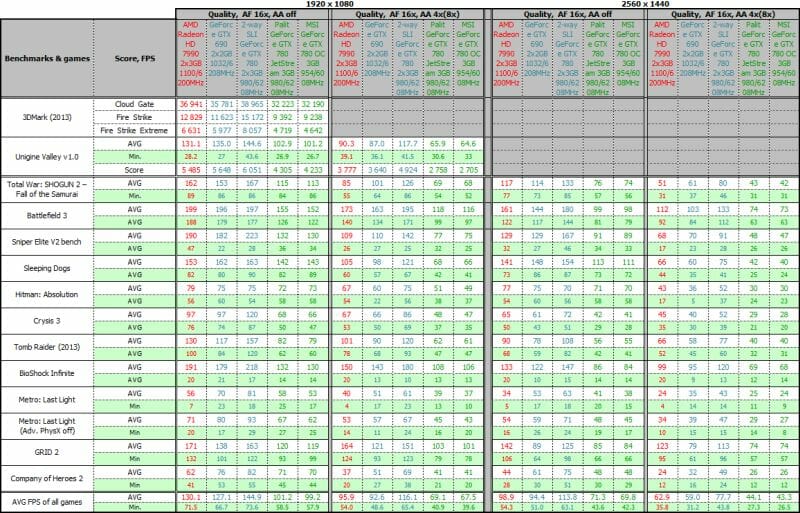
The first pair of summary charts helps compare the SLI tandem we built out of two overclocked GeForce GTX 780s against one such card:
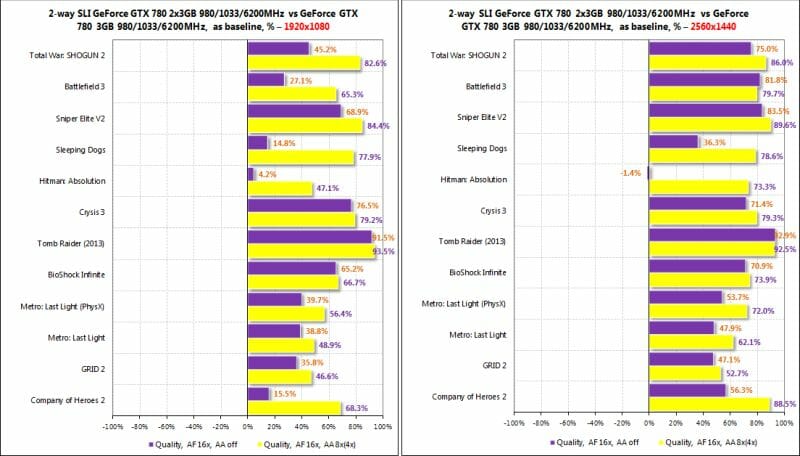
The average performance growth across all the games is 44-56% without antialiasing, which is not too much. However, top-end graphics subsystems are meant to run games at maximum visual quality settings, i.e. with antialiasing. And in this case, the 2-way GeForce GTX 780 SLI is 68 to 77% efficient. The SLI scalability is as high as 80 and 90% in Tomb Raider (2013), Total War: SHOGUN 2 – Fall of the Samurai, Battlefield 3 and Sniper Elite V2. Considering the lack of any bottom speed problems, the results are most satisfying.
Next we will compare the 2-way GeForce GTX 780 SLI tandem and the Nvidia GeForce GTX 690 which are pre-overclocked to the same level. The dual-processor card serves as the baseline in the diagram:
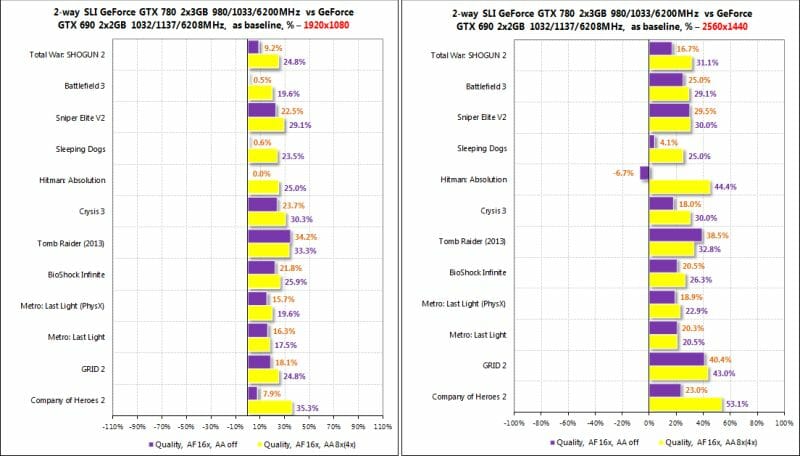
It is only in one test mode in Hitman: Absolution that the GeForce GTX 690 is ahead of the GeForce GTX 780 tandem, just because that game is too CPU-dependent without antialiasing. In the rest of the games the two GeForce GTX 780s are faster than the single GeForce GTX 690, which is quite logical considering their GPUs and pricing.
The last pair of our summary charts compares the dual-processor AMD Radeon HD 7990 and Nvidia GeForce GTX 690 at increased frequencies. We won’t comment on this comparison since it is not directly related to the topic of this review.
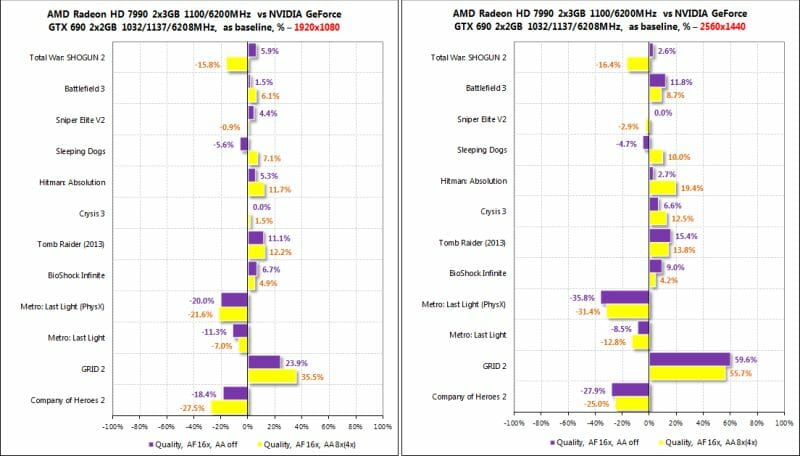
Conclusion
We’ve tested two original GeForce GTX 780s today and are very pleased with both. The MSI GeForce GTX 780 OC Gaming features a pre-overclocked GPU, an excellent high-performance and low-noise cooler, and high overclocking potential. The Palit GeForce GTX 780 Super JetStream can be praised for its even higher clock rates, 8-phase GPU power system, overclocker-targeted features, and original high-efficiency cooler with highlighting. The downsides we can note are the inconvenient position of the MSI’s power connectors and the blocking of its SLI connectors by its own stiffness rib. The Palit is rather noisy and thick, so it is impossible to use it in a SLI configuration in the top graphics slot or install two such cards one next to another. We also regret the lack of any nice extras among their accessories. After all, both products belong to the category of the fastest and most expensive single-processor graphics cards, so their buyers might expect free games or something.
As for the efficiency of the SLI tandem we built out of two GeForce GTX 780s, we had no surprises in our tests. This configuration is easily ahead of any dual-processor card from AMD and Nvidia, enjoying an advantage of 30% and more. As usual, the SLI scalability depends on software support (by the game engine and by the graphics driver). Our SLI tandem was generally free from any bottom speed problems, largely due to the large amount of onboard memory (3 GB). We want to remind you that if you build a 2-way SLI configuration out of two overclocked GeForce GTX 780s, you need a fast platform and high graphics quality settings (with some kind of antialiasing) for it to show you its very best.